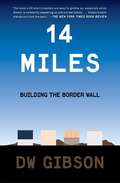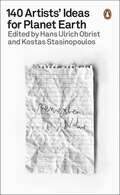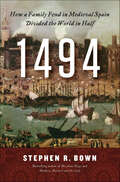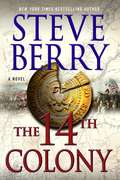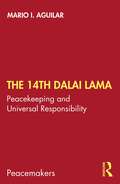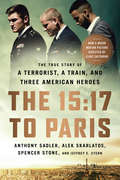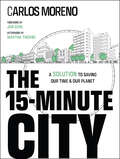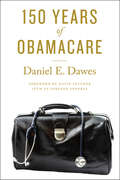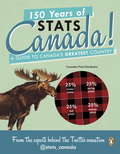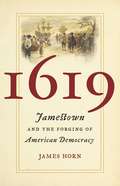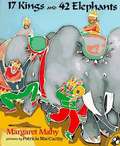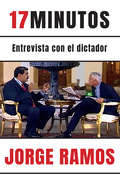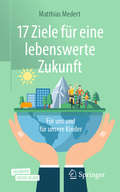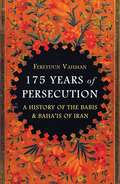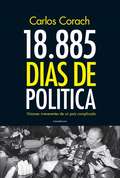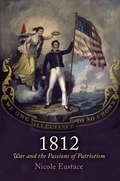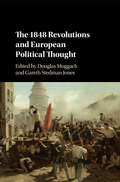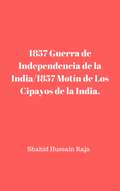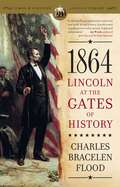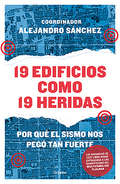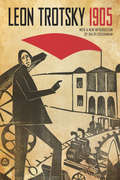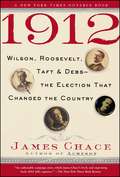- Table View
- List View
14 Miles: Building the Border Wall
by DW GibsonAn esteemed journalist delivers a compelling on-the-ground account of the construction of President Trump&’s border wall in San Diego—and the impact on the lives of local residents.In August of 2019, Donald Trump finished building his border wall—at least a portion of it. In San Diego, the Army Corps of engineers completed two years of construction on a 14-mile steel beamed barrier that extends eighteen-feet high and cost a staggering $147 million. As one border patrol agent told reporters visiting the site, &“It was funded and approved and it was built under his administration. It is Trump&’s wall.&” 14 Miles is a definitive account of all the dramatic construction, showing readers what it feels like to stand on both sides of the border looking up at the imposing and controversial barrier. After the Department of Homeland Security announced an open call for wall prototypes in 2017, DW Gibson, an award-winning journalist and Southern California native, began visiting the construction site and watching as the prototype samples were erected. Gibson spent those two years closely observing the work and interviewing local residents to understand how it was impacting them. These include April McKee, a border patrol agent leading a recruiting program that trains teenagers to work as agents; Jeff Schwilk, a retired Marine who organizes pro-wall rallies as head of the group San Diegans for Secure Borders; Roque De La Fuente, an eccentric millionaire developer who uses the construction as a promotional opportunity; and Civile Ephedouard, a Haitian refugee who spent two years migrating through Central America to the United States and anxiously awaits the results of his asylum case. Fascinating, propulsive, and incredibly timely, 14 Miles is an important work that explains not only how the wall has reshaped our landscape and countless lives but also how its shadow looms over our very identity as a nation.
140 Artists' Ideas for Planet Earth
by Hans Ulrich Obrist Kostas StasinopoulosThrough 140 drawings, thought experiments, recipes, activist instructions, gardening ideas, insurgences and personal revolutions, artists who spend their lives thinking outside the box guide you to a new worldview; where you and the planet are one.Everything here is new. We invite you to rip out pages, to hang them up at home, to draw and scribble, to cook, to meditate, to take the book to your nearest green space.Featuring Olafur Eliasson, Etel Adnan, Alexis Pauline Gumbs, Jane Fonda & Swoon, Judy Chicago, Black Quantum Futurism Collective, Vivienne Westwood, Cauleen Smith, Marina Abramovic, Karrabing Film Collective, and many more.
1494: How a Family Feud in Medieval Spain Divided the World in Half
by Stephen R. Bown"This is a starry love story, a tale of seething jealousies and subterfuge, a political imbroglio, and religious cruelties. It sounds like Shakespeare and it could have very well been the plot of one of his plays." --Toronto StarIn 1494, award-winning author Stephen R. Bown tells the untold story of the explosive feud between monarchs, clergy, and explorers that split the globe between Spain and Portugal and made the world's oceans a battleground.When Columbus triumphantly returned from America to Spain in 1493, his discoveries inflamed an already-smouldering conflict between Spain's renowned monarchs, Ferdinand and Isabella, and Portugal's João II. Which nation was to control the world's oceans? To quell the argument, Pope Alexander VI—the notorious Rodrigo Borgia—issued a proclamation laying the foundation for the Treaty of Tordesillas of 1494, an edict that created an imaginary line in the Atlantic Ocean dividing the entire known (and unknown) world between Spain and Portugal. Just as the world's oceans were about to be opened by Columbus's epochal voyage, the treaty sought to limit the seas to these two favored Catholic nations. The edict was to have a profound influence on world history: it propelled Spain and Portugal to superpower status, steered many other European nations on a collision course, and became the central grievance in two centuries of international espionage, piracy, and warfare. The treaty also began the fight for "the freedom of the seas"—the epic struggle to determine whether the world's oceans, and thus global commerce, would be controlled by the decree of an autocrat or be open to the ships of any nation—a distinctly modern notion, championed in the early seventeenth century by the Dutch legal theorist Hugo Grotius, whose arguments became the foundation of international law.At the heart of one of the greatest international diplomatic and political agreements of the last five centuries were the strained relationships and passions of a handful of powerful individuals. They were linked by a shared history, mutual animosity, and personal obligations—quarrels, rivalries, and hatreds that dated back decades. Yet the struggle ultimately stemmed from a young woman's determination to defy tradition and the king, and to choose her own husband.
The 14th Colony (Cotton Malone #11)
by Steve Berry<P>What happens if both the president and vice-president-elect die before taking the oath of office? The answer is far from certain. In fact, what follows would be nothing short of total political chaos. Shot down over Siberia, ex-Justice Department agent Cotton Malone is forced into a fight for survival against Aleksandr Zorin, a man whose loyalty to the former Soviet Union has festered for decades into an intense hatred of the United States. <P> Before escaping, Malone learns that Zorin and another ex-KGB officer, this one a sleeper still embedded in the West, are headed overseas to Washington D. C. Noon on January 20th, "Inauguration Day" is only hours away. A flaw in the Constitution, and an even more flawed presidential succession act, have opened the door to disaster and Zorin intends to exploit both weaknesses to their fullest. <P>Armed with a weapon leftover from the Cold War, one long thought to be just a myth, Zorin plans to attack. He's aided by a shocking secret hidden in the archives of America's oldest fraternal organization, "the Society of Cincinnati," a group that once lent out its military savvy to presidents, including helping to formulate three invasion plans of what was intended to be America's "14th colony," Canada. <P>In a race against the clock that starts in the frozen extremes of Russia and ultimately ends at the White House itself, Malone must not only battle Zorin, he must also confront a crippling fear that he's long denied, but which now jeopardizes everything. Steve Berry's trademark mix of history and speculation is all here in this provocative new thriller. <P><b>A New York Times Bestseller</b>
The 14th Dalai Lama: Peacekeeping and Universal Responsibility (Peacemakers)
by Mario I. AguilarThis book outlines the life of spiritual diplomacy of the 14th Dalai Lama and his emergence as a global peace icon. It traces his evolution as a Tibetan Buddhist monk rooted in the Geluk tradition, as a Nobel laureate, and as an internationally recognized peacemaker. The volume brings to the fore the Dalai Lama’s monastic life grounded in the compassion and ethical responsibility of a bodhisattva, somebody who is willing to renounce samsara for the benefit of others, as well as that of a political leader of Tibet. It examines the deep impact of his ideas of peacekeeping and universal responsibility on world politics, which draw on acceptance, inclusion, and respect as their central pillars. Further, this book highlights his departure from the practices of the earlier Dalai Lamas, and how the Chinese invasion and his exile in India transformed him into a universal figure of peace, rather than solely being the leader of Tibet. An introspective read, this book will be of much interest to readers interested in spiritual diplomacy and political philosophy. It will also be of interest to scholars and researchers of peace and conflict studies, international relations, politics, and religion, especially Buddhism.
The 15: The True Story of a Terrorist, a Train, and Three American Heroes
by Alek Skarlatos Anthony Sadler Jeffrey E. Stern Spencer StoneAn ISIS terrorist planned to kill more than 500 people. He would have succeeded except for three American friends who refused to give in to fear.On August 21, 2015, Ayoub El-Khazzani boarded train #9364 in Brussels, bound for Paris. There could be no doubt about his mission: he had an AK-47, a pistol, a box cutter, and enough ammunition to obliterate every passenger on board. Slipping into the bathroom in secret, he armed his weapons. Another major ISIS attack was about to begin.Khazzani wasn't expecting Anthony Sadler, Alek Skarlatos, and Spencer Stone. Stone was a martial arts enthusiast and airman first class in the US Air Force, Skarlatos was a member of the Oregon National Guard, and all three were fearless. But their decision-to charge the gunman, then overpower him even as he turned first his gun, then his knife, on Stone-depended on a lifetime of loyalty, support, and faith.Their friendship was forged as they came of age together in California: going to church, playing paintball, teaching each other to swear, and sticking together when they got in trouble at school. Years later, that friendship would give all of them the courage to stand in the path of one of the world's deadliest terrorist organizations.The 15:17 to Paris is an amazing true story of friendship and bravery, of near tragedy averted by three young men who found the heroic unity and strength inside themselves at the moment when they, and 500 other innocent travelers, needed it most.
The 15-Minute City: A Solution to Saving Our Time and Our Planet
by Carlos MorenoA fresh and innovative perspective on urban issues and creating sustainable cities In The 15-Minute City: A Solution for Saving Our Time and Our Planet, human city pioneer and international scientific advisor Carlos Moreno delivers an exciting and insightful discussion of the deceptively simple and revolutionary idea that everyday destinations like schools, stores, and offices should only be a short walk or bike ride away from home. This book tells the story of an idea that spread from city to city, describing a new way of looking at living that addresses many of the most intractable challenges of our time. Hundreds of mayors worldwide have already embraced the concept as a way to help recover from the pandemic, and the idea continues to gain speed. You'll learn why more and more cities are planning to make cars far less necessary for contemporary city-dwellers and how they're planning to achieve that goal. You'll also find: Strategies for cities to recover and adapt to benefit residents, saving them precious time Techniques to change the habits of automobile-dependent city residents and maximize social benefits of living in a human-centric city Scientifically developed, research-backed solutions for enduring urban issues and problems Deeply committed to science, progress, and creativity, Moreno presents an essential and timely resource in The 15-Minute City, which will prove invaluable to anyone with an interest in modern and innovative approaches to consistently challenging urban issues that have bedeviled policy makers and city residents since the invention of the car.
150 Jahre Gesetzgebung in Deutschland: Entwicklungen des Gesetzgebungsverfahrens von der konstitutionellen Monarchie 1871 bis zur parlamentarischen Demokratie 2021
by Martin H. MöllersDieses Buch erläutert die verfassungsmäßige Ausgestaltung der Gesetzgebungsverfahren im Kaiserreich, in der Weimarer Republik und in der Bundesrepublik Deutschland im Zusammenhang. Dadurch wird nachvollziehbar, dass die Gesetzgebung der heutigen parlamentarischen Demokratie ihre Basis bereits in der konstitutionellen Monarchie des Deutschen Kaiserreichs vor 150 Jahren hat. Obwohl das Verfahren der Gesetzgebung im Kaiserreich vordemokratisch ausgestaltet war, sind ihre wesentlichen Merkmale bis heute unverändert. Welche Änderungen die Gesetzgebungsverfahren von Verfassung zu Verfassung im Einzelnen erfuhren, analysiert das Buch und stellt heraus, dass diese Änderungen vor allem das Bund-Länder-Verhältnis, die Volkssouveränität sowie den Einfluss der Grundrechte auf die Gesetzgebung betrafen. Dabei kommen auch Auffassungen der Staatsrechtslehre früherer Zeiten zur Rechtsstaatlichkeit zur Sprache, die immer noch zum derzeitigen Meinungsspektrum zählen, heute jedoch nicht mehr zu halten sind. Zudem dokumentiert das Buch, wer an den Gesetzgebungsverfahren offiziell und wer faktisch beteiligt war bzw. noch ist und welche politischen Einflussnahmen auf die Gesetzgebung im Lauf der Geschichte festzustellen sind. So wird u.a. dokumentiert, dass insbesondere der Mangel an Transparenz der Zusammenarbeit von Exekutive und Legislative mit Lobbyisten dazu führt, dass viele Gesetze einzelne Bevölkerungsgruppen oder Wirtschaftszweige bevorzugen.
150 Years of ObamaCare
by Daniel E. DawesGo behind the curtain of the creation and implementation of the Affordable Care Act.In this groundbreaking book, health-care attorney Daniel E. Dawes explores the secret backstory of the Affordable Care Act, shedding light on the creation and implementation of the greatest and most sweeping equalizer in the history of American health care. An eye-opening and authoritative narrative written from an insider’s perspective, 150 Years of ObamaCare debunks contemporary understandings of health reform. It also provides a comprehensive and unprecedented review of the health equity movement and the little-known leadership efforts that were crucial to passing public policies and laws reforming mental health, minority health, and universal health.An instrumental player in a large coalition of organizations that helped shape ObamaCare, Dawes tells the story of the Affordable Care Act with urgency and intimate detail. He reveals what went on behind the scenes by including copies of letters and e-mails written by the people and groups who worked to craft and pass the law. Dawes explains the law through a health equity lens, focusing on what it is meant to do and how it affects various groups. Ultimately, he argues that ObamaCare is much more comprehensive in the context of previous reform efforts than is typically understood.In an increasingly polarized political environment, health reform has been caught in the cross fire of the partisan struggle, making it difficult to separate fact from fiction. Offering unparalleled and complete insight into the efforts by the Obama administration, Congress, and external stakeholders, 150 Years of ObamaCare illuminates one of the most challenging legislative feats in the history of the United States.
150 Years of Stats Canada!: A Guide to Canada's Greatest Country
by Stats CanadaCanada's funniest online sensation is back to celebrate the country's 150th anniversary--bigger, bolder, and only 10% reused material!Want to know what the hottest new Canadian apps are? Need a handy chart to help you decide what Can-Con music to listen to? How about the top Google searches across the nation? In this handy guide to Canada, the tireless experts at @stats_canada reveal all the must-know quirks from coast to coast to frigid coast. From helpful tips on the Vancouver housing market to planning the ultimate Montreal bachelor party, Stats Can is on the case. And discover just how Canadian you are with the official checklist, not to mention the Tim Hortons etiquette quiz. With crucial updates about Canada on its big birthday, and all the stats, charts, and graphs to back them up, 150 Years of Stats Canada! is the perfect way to celebrate everything we love about this great country. Disclaimer: still 100.6% not affiliated with Statistics Canada
1619: Jamestown and the Forging of American Democracy (Published By The Omohundro Institute Of Early American History And Culture And The University Of North Carolina Press Ser.)
by James HornAn extraordinary year in which American democracy and American slavery emerged hand in handAlong the banks of the James River, Virginia, during an oppressively hot spell in the middle of summer 1619, two events occurred within a few weeks of each other that would profoundly shape the course of history. In the newly built church at Jamestown, the General Assembly--the first gathering of a representative governing body in America--came together. A few weeks later, a battered privateer entered the Chesapeake Bay carrying the first African slaves to land on mainland English America.In 1619, historian James Horn sheds new light on the year that gave birth to the great paradox of our nation: slavery in the midst of freedom. This portentous year marked both the origin of the most important political development in American history, the rise of democracy, and the emergence of what would in time become one of the nation's greatest challenges: the corrosive legacy of racial inequality that has afflicted America since its beginning.
17 Kings and 42 Elephants
by Margaret MahyWhere those kings are headed is a mystery, but no travelers ever had such a jolly time. Here is a royal romp through a tongue-twisting paradise.
17 minutos: Entrevista con el dictador
by Jorge Ramos ÁvalosEl libro sobre cómo el autor desenmascaró a Maduro ante las cámaras: con todo lo que ocurrió antes y después. El 25 de febrero de 2019, apoyado por su equipo de Univisión, Jorge Ramos realizó una entrevista al dictador de Venezuela, Nicolás Maduro. Preparada minuciosamente, pasado el primer cuarto de hora, y luego de evidenciar su disgusto por el severo cuestionamiento del periodista (fiel a su compromiso de confrontar a los poderosos), el entrevistado la dio por terminada abruptamente. Se producía así un tremendo acto de censura que implicó confiscar el equipo de grabación, la detención del periodista y finalmente su deportación. Con un estilo directo y crítico, Jorge narra los recovecos de esta peligrosa experiencia periodística que tuvo repercusión mundial, incluyendo lo que hizo para no ser encarcelado, salvar a sus colaboradores y recuperar, tiempo después, la entrevista requisada.
17 Ziele für eine lebenswerte Zukunft: Für uns und für unsere Kinder
by Matthias MedertVielleicht machst auch du dir Sorgen darüber, wohin die vielen ökologischen und sozialen Probleme führen werden, von welcher Art und Ausmaß die Konsequenzen sein können und wie diese das Leben von Menschen betreffen werden? Dann könnte dieses Buch interessant für Dich sein: Es beschreibt anhand der 17 UN-Nachhaltigkeitsziele eine Vision für eine lebenswerte Zukunft. Du erfährst kurz und verständlich zu jedem der Ziele konkrete Hintergründe, Zusammenhänge und Herausforderungen, die es auf dem Weg dorthin noch zu meistern gilt. Es macht die Themen greifbar - sowohl global als auch bezogen auf Deutschland. Gleichzeitig liefert Dir das Buch Anregungen, wie Du selbst dazu beitragen kannst, die großen Probleme der Menschheit zu lösen: Klimawandel, Energie, Plastikmüll, Artenvielfalt, Umweltschutz, Hunger, Armut, etc.Zusammen können wir es schaffen, die 17 Ziele umzusetzen, indem wir sie mit konkreten Inhalten füllen. Falls uns das gelingt fragen unsere Kinder vielleicht eines Tages: „Wie habt ihr damals die Erde gerettet und die Menschheit in das Zeitalter der sozialen Gerechtigkeit geführt?“
175 Years of Persecution: A History of the Babis & Baha'is of Iran
by Fereydun VahmanFor almost two centuries, followers of the Baha&’i faith, Iran&’s largest religious minority, have been persecuted by the state. They have been made scapegoats for the nation&’s ills, branded enemies of Islam and denounced as foreign agents. Since the Islamic Revolution of 1979 Baha&’is have been barred from entering the nation&’s universities, more than two hundred have been executed, and hundreds more imprisoned and tortured. Now, however, Iran is at a turning point. A new generation has begun to question how the Baha&’is have been portrayed by the government and the clergy, and called for them to be given equal rights as fellow citizens. In documenting, for the first time, the plight of this religious community in Iran since its inception, Fereydun Vahman also reveals the greater plight of a nation aspiring to develop a modern identity built on respect for diversity rather than hatred and self-deception.
18.885 días de política: Visiones irreverentes de un país complicado
by Carlos CorachUn interesante y lúcido relato de memorias de 18.885 días de actividadpolítica, que se leen en uno. Carlos Corach confiesa aquí que ha vivido (y sigue viviendo) una intensavida política: del desarrollismo al menemismo, del Colegio Nacional deBuenos Aires al Pacto de Olivos, el ex ministro del Interior repasa cadapeldaño, cada alegría, cada traspié y cada enseñanza de su carrera. Noevita tema alguno y subraya en todos una necesidad que hoy pareceolvidada: la del diálogo como herramienta principal de la política. DiceCorach en estas memorias como un apasionante manual de historiaargentina reciente: «Entendí que la política exige comprender y aceptarla diversidad de opiniones, que siempre hay que dialogar con aquelloscon quienes disentimos y que la relación con los adversarios,permanentes o circunstanciales, exige siempre el respeto mutuo».
1812
by Nicole EustaceAs military campaigns go, the War of 1812 was a disaster. By the time it ended in 1815, Washington, D.C., had been burned to the ground, the national debt had nearly tripled, and territorial gains were negligible. Yet the war gained so much popular support that it ushered in what is known as the "era of good feelings," a period of relative partisan harmony and strengthened national identity. Historian Nicole Eustace's cultural history of the war tells the story of how an expensive, unproductive campaign won over a young nation--largely by appealing to the heart.1812 looks at the way each major event of the war became an opportunity to capture the American imagination: from the first attempt at invading Canada, intended as the grand opening of the war; to the battle of Lake Erie, where Oliver Perry hoisted the flag famously inscribed with "Don't Give Up the Ship"; to the burning of the Capitol by the British. Presidential speeches and political cartoons, tavern songs and treatises appealed to the emotions, painting war as an adventure that could expand the land and improve opportunities for American families. The general population, mostly shielded from the worst elements of the war, could imagine themselves participants in a great national movement without much sacrifice. Bolstered with compelling images of heroic fighting men and the loyal women who bore children for the nation, war supporters played on romantic notions of familial love to espouse population expansion and territorial aggression while maintaining limitations on citizenship. 1812 demonstrates the significance of this conflict in American history: the war that inspired "The Star-Spangled Banner" laid the groundwork for a patriotism that still reverberates today.
The 1848 Revolutions and European Political Thought
by Gareth Stedman Jones Douglas MoggachThe revolutions that swept across Europe in 1848 marked a turning-point in the history of political and social thought. They raised questions of democracy, nationhood, freedom and social cohesion that have remained among the key issues of modern politics, and still help to define the major ideological currents - liberalism, socialism, republicanism, anarchism, conservatism - in which these questions continue to be debated today. This collection of essays by internationally prominent historians of political thought examines the 1848 Revolutions in a pan-European perspective, and offers research on questions of state power, nationality, religion, the economy, poverty, labour, and freedom. Even where the revolutionary movements failed to achieve their explicit objectives of transforming the state and social relations, they set the agenda for subsequent regimes, and contributed to the shaping of modern European thought and institutions.
1857 Guerra de Independencia de la India/1857 Motín de Los Cipayos de la India.
by Shahid Hussain RajaEl 27 de abril de 1857, ochenta y cinco soldados de un regimiento Bengalí de la British East Indian Company, publicado en Meerut, desobedecieron las órdenes de su oficial británico superior, de usar los nuevos cartuchos para los nuevos rifles Enfield, presuntamente empacados en grasa de vaca y cerdo. Se les impuso un castigo severo a los soldados desobedientes, y esto también frente a sus colegas, resultando en el motín de varios regimientos y finalmente se convirtió en un levantamiento general de la gente de India. Fueron despiadadamente reprimidos por los británicos con la ayuda de su tecnología superior y soporte de las élites locales. Sin embargo, como cualquier evento cataclísmico, dio origen a diferentes tendencias sociales, políticas y económicas, las cuales todavía están dando forma al curso de acontecimientos en los estados postcoloniales de India, Pakistán, Bangladesh y otros países del subcontinente Indio. Este pequeño manual intenta descubrir la naturaleza, causas y consecuencias de este hito tan importante de la historia de las luchas de la gente de India por la Independencia. Esto explica el trasfondo de la Guerra de Independencia de India en 1857 o como algunos escritores le llaman, El Motín de los Cipayos de la India de 1857, enumera en detalle las causas sociales, económicas y políticas de este acontecimiento trascendental, narra el curso de los eventos, razones de su fracaso y termina con un análisis acerca del impacto a largo y corto plazo. Por último, argumenta que muchas de las tendencias de hoy en día en India, Pakistán y Bangladesh tienen sus raíces en políticas adoptadas por los administradores británicos en las secuelas de este levantamiento.
1857 Indischer Unabhängigkeitskrieg (Meuterei der indischen Sepoys): Ursachen und Folgen
by Shahid Hussain RajaErläutert die Hintergründe des indischen Unabhängigkeitskrieges von 1857 oder das, was ein Teil der Schriftsteller als "Sepoy's Mutiny" von 1857 bezeichnet, zählt detailliert die sozialen, wirtschaftlichen und politischen Ursachen dieses folgenschweren Ereignisses auf, schildert den Verlauf der Ereignisse, die Gründe für das Scheitern und endet mit einer detaillierten Analyse der lang- und kurzfristigen Auswirkungen.
1864
by Charles Bracelen FloodIn a masterful narrative, historian and biographer Charles Bracelen Flood brings to life the drama of Lincoln's final year, in which he oversaw the last campaigns of the Civil War, was reelected as president, and laid out his majestic vision for the nation's future in a reunified South and in the expanding West.
18885 DÍAS DE POLITICA (EBOOK)
by Carlos CorachCarlos Corach confiesa aquí que ha vivido (y sigue viviendo) una intensa vida política: del desarrollismo al menemismo, del Colegio Nacional de Buenos Aires al Pacto de Olivos, el ex ministro del Interior repasa cada peldaño, cada alegría, cada traspié y cada enseñanza de su carrera. No evita tema alguno y subraya en todos una necesidad que hoy parece olvidada: la del diálogo como herramienta principal de la política. Dice Corach, en estas memorias de 18.885 días que se leen en uno, como un apasionante manual de historia argentina reciente: "Entendí que la política exige comprender y aceptar la diversidad de opiniones, que siempre hay que dialogar con aquellos con quienes disentimos y que la relación con los adversarios, permanentes o circunstanciales, exige siempre el respeto mutuo".
19 edificios como 19 heridas: Por qué el sismo nos pegó tan fuerte
by Alejandro SánchezEl 19 de septiembre de 2017 un terremoto azotó México. Murieron 369 personas. Pero no las mató el sismo. Los responsables fueron la corrupción, la impunidad, la dejadez, el olvido e incluso la falta de cultura cívica. A un año del desastre, esta obra investiga qué salió mal en 19 de los edificios más dañados por el temblor. ¿Por qué hubo tantos muertos 32 años después del terremoto de 1985? El libro, así, pinta cuáles son los problemas que resquebrajaron México... y alerta: si no se solucionan, volverá a ocurrir una tragedia similar. Reportajes de: Óscar Alarcón - Hugo Corzo Zanabria - Silvia Garduño Francisco Goldman - Édgar Ledesma Gasca - Albinson Linares Francisco Nieto - Ernesto Núñez Albarrán - Georgina Olson Jiménez Peniley Ramírez - Paris Alejandro Salazar - Nantzin Saldaña Neldy San Martín # Alejandro Sánchez - Laura Sánchez Ley Claudia Solera - Laura Toribio - Daniel Venegas. Las ganancias de este libro serán entregadas a los damnificados del Multifamiliar Tlalpan.
1905
by Leon TrotskyLeon Trotsky's 1905-despite long being out of print-has remained the central point of reference for those looking to understand the rising of workers, peasants, and soldiers that nearly unseated the Tsar in 1905. Trotsky's elegant, beautifully written account draws on his experience as a key leader of the revolution.
1912
by James ChaceFour extraordinary men sought the presidency in 1912. Theodore Roosevelt was the charismatic and still wildly popular former president who sought to redirect the Republican Party toward a more nationalistic, less materialistic brand of conservatism and the cause of social justice. His handpicked successor and close friend, William Howard Taft, was a reluctant politician whose sole ambition was to sit on the U.S. Supreme Court. Amiable and easygoing, Taft was the very opposite of the restless Roosevelt. After Taft failed to carry forward his predecessor's reformist policies, an embittered Roosevelt decided to challenge Taft for the party's nomination. Thwarted by a convention controlled by Taft, Roosevelt abandoned the GOP and ran in the general election as the candidate of a third party of his own creation, the Bull Moose Progressives.Woodrow Wilson, the former president of Princeton University, astonished everyone by seizing the Democratic nomination from the party bosses who had made him New Jersey's governor. A noted political theorist, he was a relative newcomer to the practice of governing, torn between his fear of radical reform and his belief in limited government. The fourth candidate, labor leader Eugene V. Debs, had run for president on the Socialist ticket twice before. A fervent warrior in the cause of economic justice for the laboring class, he was a force to be reckoned with in the great debate over how to mitigate the excesses of industrial capitalism that was at the heart of the 1912 election.Chace recounts all the excitement and pathos of a singular moment in American history: the crucial primaries, the Republicans' bitter nominating convention that forever split the party, Wilson's stunning victory on the forty-sixth ballot at the Democratic convention, Roosevelt's spectacular coast-to-coast whistle-stop electioneering, Taft's stubborn refusal to fight back against his former mentor, Debs's electrifying campaign appearances, and Wilson's "accidental election" by less than a majority of the popular vote.Had Roosevelt received the Republican nomination, he almost surely would have been elected president once again and the Republicans would likely have become a party of reform. Instead, the GOP passed into the hands of a conservative ascendancy that reached its fullness with Ronald Reagan and George W. Bush, and the party remains to this day riven by the struggle between reform and reaction, isolationism and internationalism. The 1912 presidential contest was the first since the days of Jefferson and Hamilton in which the great question of America's exceptional destiny was debated. 1912 changed America.
